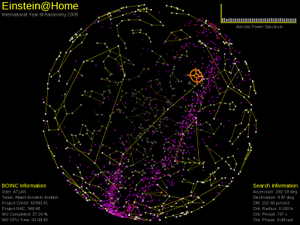WARNING: This website is obsolete! Please follow this link to get to the new Einstein@Home website!
The Einstein@Home Arecibo Radio Pulsar search: Topic 2 |
|
Why do we search for radio pulsars in binary systems? |
[previous] [home] [next] |
||||
|
Most pulsars are weak sources and require the use of large radio telescopes to detect them. Astronomers have scanned the complete sky with various telescopes and detected pulsars in the Milky Way and nearby globular clusters. Pulsars in other galaxies are out of reach of our detectors. Most known pulsars were only found by "integrating" their signal: superposing a large number of pulses in a coordinated way to make the actual "pulse" signal stand out from the "static". This procedure doesn't work as well for pulsars in most short-period binary systems. Since we see most binary systems from the side or inclined, the time-delay between the near and far points of the orbit smears out the signal making it harder to distinguish it from the noise. That's unfortunate since many stars are not solitary but members of a binary system. Thus, a significant fraction of pulsars are being missed in the surveys. |
|
Last updated on 10 June 2009
This material is based upon work supported by the National Science Foundation (NSF) under Grants PHY-1104902, PHY-1104617 and PHY-1105572 and by the Max Planck Gesellschaft (MPG). Any opinions, findings, and conclusions or recommendations expressed in this material are those of the investigators and do not necessarily reflect the views of the NSF or the MPG.
Copyright © 2025 Einstein@Home

